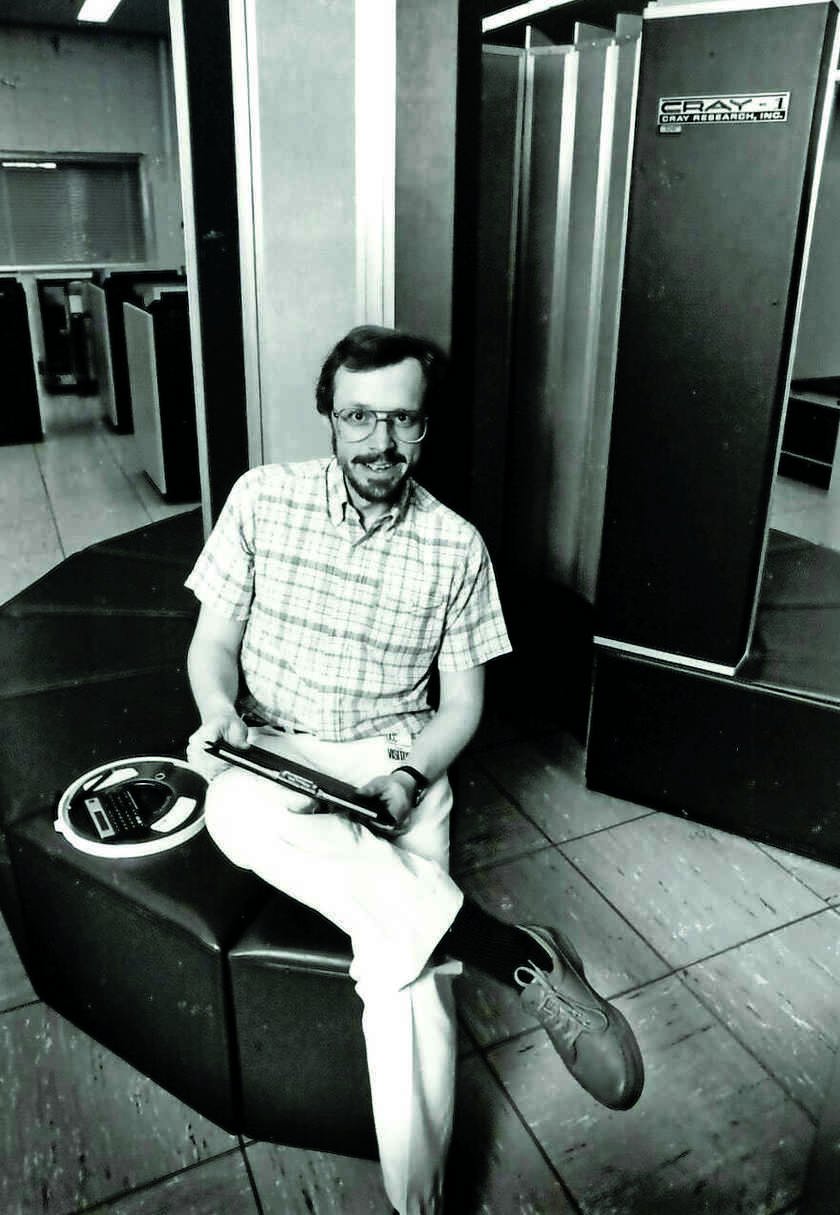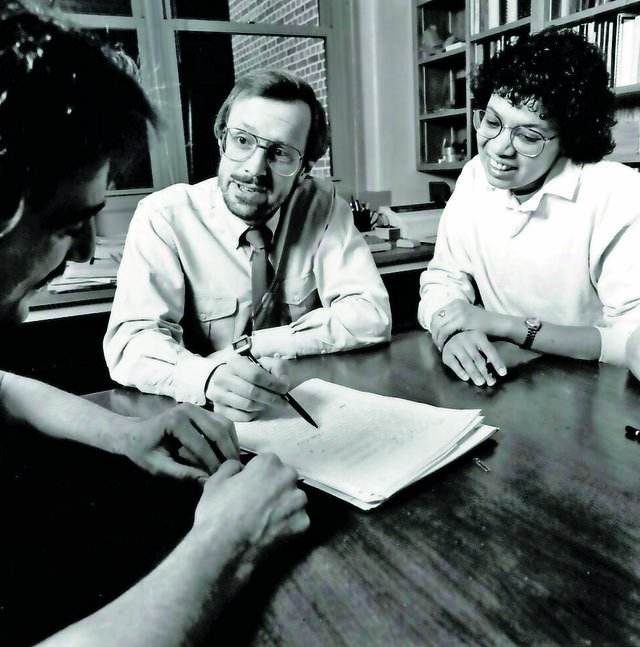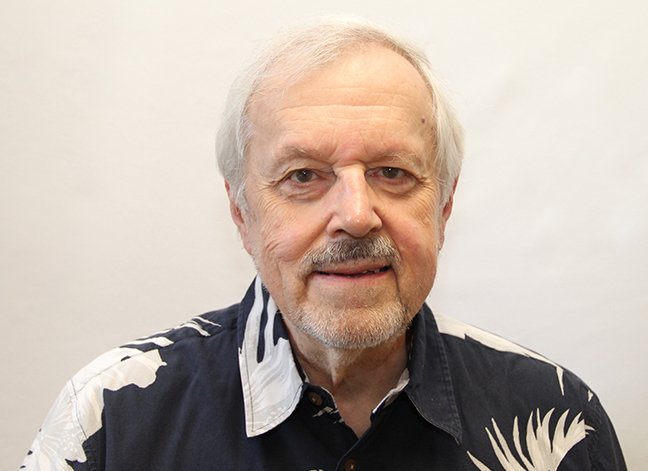Two professors celebrate decades of research, teaching, and service

Pillars of the department's community
MINNEAPOLIS / ST. PAUL (07/21/2020)—Two Department of Chemistry professors, Wayne Gladfelter and Donald Truhlar, are celebrating significant anniversaries with the University of Minnesota in 2019. Gladfelter has been with the faculty in chemistry for 40 years, and Truhlar has been with the department for 50 years. For both of these outstanding professors, their tenures are marked with outstanding research, excellent teaching and mentoring, and deep commitment to service to their profession.
Wayne L. Gladfelter
Throughout his 40-year career at the University of Minnesota, Professor Wayne Gladfelter has assembled a remarkable record of service to the Department of Chemistry, the College of Science & Engineering (CSE), the University of Minnesota (UMN), and to the discipline of chemistry beyond the university. At all levels, Gladfelter has been lauded for his commitment to providing excellent leadership, his willingness to accept challenging assignments, and his acumen as a creative problem-solver.
Since joining the Department of Chemistry faculty in 1979, Gladfelter’s service record in the department has been extensive. Early in his career, he served for five years on the Graduate Committee, responsible for recruiting new students and overseeing student progress. He also served a three-year term as director of Graduate Studies. He has led or served on a number of department committees, including tenure and promotion, and faculty search.
In 1999, Gladfelter was appointed chair of the Department of Chemistry, a position he held for six years. During his tenure, he oversaw the planning, design, and fund-raising effort for the department’s LeClaire-Dow Instrumentation Facility, which houses the nuclear magnetic resonance, mass spectrometry, and X-ray crystallographic laboratories. He also led the department through a centennial celebration, and through transitions taking place at the college and university levels.

Service to college and University
Shortly after stepping down as department chair, Gladfelter was asked to serve as the college’s associate dean of Academic Affairs. He worked with other college leaders to navigate a number of changes, opportunities and challenges, including a name change for the college, transformation of the Graduate School, expansion of undergraduate enrollment, increases in the number of faculty, and expansion of graduate programs. A tough challenge encompassed working through revisions to criteria for tenure and promotion. He led the college’s expanded efforts on diversity initiatives, including salary equity reviews and the recruitment of a diverse faculty. As a tireless advocate for women faculty, he provided programming and resources to allow women to meet and discuss issues that were important for advancement, work-life balance, and success.
In 2014, Gladfelter accepted the responsibility of leading the university’s MnDRIVE hiring initiative on Robotics, Sensors, and Advanced Manufacturing, which included recruiting and hiring new faculty members. Under his leadership, six new faculty members were hired in four departments and two colleges.
In addition to the Department of Chemistry’s instrumentation facility, Gladfelter has been extensively involved in the University’s Characterization Facility, including serving as administrator and as chair and member of its executive committee. In 1992, he was the principal investigator on a successful National Science Foundation (NSF) proposal to purchase a new Rutherford backscattering spectrometer. In 2014, he organized an NSF magnetic resonance imaging request to purchase a new $1.2 million surface analysis system for the facility.
Service to broader scientific community
Gladfelter has also been extremely active in promoting chemistry to the broader scientific community, including through the American Chemical Society (ACS), the Materials Research Society, the Council for Chemical Research, and the American Association for the Advancement of Science (AAAS). He served as chair of the AAAS chemistry section and was treasurer of the ACS Division of Inorganic Chemistry. His contributions include serving in leadership roles and organizing symposia for the ACS, National Science Foundation, and Materials Research Society. He has served on the advisory boards for many scientific journals, including Inorganic Chemistry, Journal of Coordination Chemistry, Ceramics International, and Chemical Vapor Deposition. He has been honored as a Fellow of the AAAS, and by the College of Science and Engineering with its George W. Taylor Award for Distinguished Service.
Research and teaching
In addition, Gladfelter has a distinguished record of research and teaching. He has graduated more than 50 doctorate students and, with them, has co-authored more than 250 papers. Gladfelter has also mentored 15 post-doctoral associates and advised 65 undergraduate researchers. He is one of the college’s Distinguished Professors honored for his contributions to teaching and scholarly research, and commitment to the college.
Gladfelter’s early research focused on metal cluster chemistry and included discoveries of bi- and polynuclear compounds incorporating nitrido, nitrosyl and related ligands that included the first examples of anion-promoted homogeneous catalytic reactions of metal carbonyl clusters. His work included a series of elegant studies of the mechanism of the catalytic carbonylation of nitroaromatics, which is an environmentally friendlier approach to aromatic isocyanates. He also made important contributions to the field of materials chemistry, including the first publications on the use of alanes (aluminum hydride compounds) for the deposition of metallic aluminum and aluminum-containing films. One example, dimethylethylamine alane, first published by the Gladfelter group, remains an important, commercially available precursor for many applications. In related studies, the Gladfelter group synthesized and characterized many gallium nitrogen molecules, including the isolation of cyclotrigallazane (looks like cyclohexane), which can be converted into gallium nitride nanoparticles.
Collaborations and multidisciplinary research have always been important components of Gladfelter’s program. For instance, the collaboration with Professor Stephen Campbell in Electrical and Computing Engineering led to the first field effect transistors using titanium dioxide (deposited by Gladfelter’s precursors) as the high k dielectric. Additional collaborations with UMN faculty have included John Evans, Klavs Jensen, Alfonso Franciosi, Christopher Cramer, Jeffrey Roberts, Victor Young, David Norris, David Blank, Kent Mann, Marc Hillmyer, Larry Miller, Ilja Siepmann, and Christopher Leighton. As a member of the NSF-funded Center for Interfacial Engineering, Gladfelter and Greg Haugstad, Ph.D., collaborated with industrial members to study the surface morphology and properties of gelatin and other polymer films using scanning probe microscopy.
Currently, he is seeking to understand the mechanism of charge separation in dye-sensitized solar cells by studying the early events following excitation of dye molecules attached to individual ZnO nanocrystals. In another project, he is developing new molecular precursors and exploring the reaction mechanisms for the atomic layer deposition of metal oxide films where ozone is used as the oxide source.
“None of the above research would have been possible without an outstanding group of graduate students, postdoctoral associates and undergraduates,” said Professor Gladfelter.
About Professor Gladfelter
Professor Gladfelter earned his Bachelor of Science degree in Mineral Engineering Chemistry from the Colorado School of Mines and his doctorate from the Pennsylvania State University. He was an NSF post-doctoral fellow at the California Institute of Technology after which he joined the Department of Chemistry at Minnesota in 1979. He met his wife, Betty, at Penn State and they have two children and two grandchildren. Outside of chemistry, he enjoys golf and learning about wine.
Donald G. Truhlar
Regents Professor Donald Truhlar is renowned as one the top theoretical chemists in the world and has received numerous accolades for his contributions to the profession, and his unparalleled teaching and advising.
Multifaceted research
Tuhlar’s multifaceted research in theoretical and computational chemistry focuses on kinetics, dynamics, solvation, electronic structure, thermochemistry, and catalysis. Special emphases encompass:
- study of photoactivated processes, for which his work includes excitation energies, potential energy surfaces and their couplings, and multi-state dynamics;
- incorporation of quantum effects in dynamics, including tunneling, vibrational quantization and anharmonicity, coherence and decoherence, and electronic state switching;
- variational transition state theory applied to gas-phase and condensed-phase reactions, with special emphasis on atmospheric chemistry, combustion, enzyme kinetics, nanodusty plasmas, and surface science;
- electronic structure theory such as wave function theory, density functional theory, and combined quantum mechanical–molecular mechanical methods;
- development of broadly accurate density functionals and density functional methods for electronic structure calculations by Kohn-Sham theory and multiconfiguration pair-density functional theory;
- transition metal chemistry, with a special emphasis on catalysis; computational thermochemistry, including free energies of complex species in the gas phase and solution, solvation free energies, and electrochemistry; and
- new methods for path integral calculations in quantum mechanical statistical mechanics; and lithium-ion battery development: structure, electromotive force, capacity, and transport.
His seminal research contributions have advanced and transformed chemistry and chemical physics. This encompasses publishing 1,227 papers and 87 book chapters. He also has edited 13 books. According to Google Scholar Citations, Truhlar’s publications have been cited 157,220 times with an h index of 168. He is lauded annually for the number of citations his research articles receive.
Truhlar has gleaned numerous accolades for his research and contributions to the profession such as the 2019 American Chemical Society Award in Theoretical Chemistry, 2016 Earle K. Plyler Prize for Molecular Spectroscopy and Dynamics, American Chemical Society (ACS) Award for Computers in Chemical and Pharmaceutical Research, ACS Peter Debye Award for Physical Chemistry, Schrödinger Medal of The World Association of Theoretical and Computational Chemists, Dudley R. Herschbach Award for Excellence in Research in Collision Dynamics, Royal Society of Chemistry Chemical Dynamics Award, National Academy of Sciences Award for Scientific Reviewing, Distinguished Alumnus Award of St. Mary’s University of Minnesota, and the Minnesota Award of the Minnesota Section of the ACS. In 2015, the ACS honored Truhlar with a symposium for his contributions to and advancement of theory and computation in the understanding of the structure, energetics, and dynamics of molecules in gas phase, macromolecular, and condensed-phase systems.

Distinguished professor
Truhlar is one of the Department of Chemistry's most distinguished professors, honored for his mentorship, teaching, research, and service. In 2006, he was named a Regents Professor, the University of Minnesota's highest faculty honor. In 1998, he received the George W. Taylor Award for Distinguished Service, recognized for his outstanding service to the university and voluntary public service externally.
His teaching and advising records are unparalleled. He has taught numerous graduate and undergraduate courses and has mentored more than 182 graduate students and post-doctoral associates and 87 undergraduate research students. He has been honored for his roles as a mentor and adviser with the Graduate and Professional Student Assembly Outstanding Adviser Award, and the Council of Graduate Students’ Outstanding Faculty Award, and Outstanding Advising and Mentoring Award.

Service to scientific community
Truhlar's contributions to the scientific community include service as an associate editor for the Journal of the American Chemical Society and principal editor of Computer Physics Communications. He is also past editor of Theoretical Chemistry Accounts and currently serves as chief advisory editor of that journal as well as on several other editorial boards. He was honored by the American Physical Society as an Outstanding Referee of the Physical Review and Physical Review Letters, recognized for his help in assessing manuscripts for publication, and for providing invaluable reports and advice to authors, researchers, students, and readers. In addition, he has served on a number of ACS and American Physical Society councils and committees, and planned symposia, conferences, and workshops.
He is a member of the American Academy of Arts and Sciences, the National Academy of Sciences of the United States of America, and the International Academy of Quantum Molecular Sciences. He is a fellow of the American Association for the Advancement of Science, the American Physical Society, the American Chemical Society, the Royal Society of Chemistry, World Association of Theoretical and Computational Chemists, and the Minnesota Supercomputing Institute as well as an honorary fellow of the Chinese Chemical Society.
About Regents Professor Donald Truhlar
Truhlar earned a Bachelor of Arts in chemistry from Saint Mary's College (now St. Mary’s University of Minnesota), and a doctorate from the California Institute of Technology (Caltech) in 1970. He joined the Department of Chemistry faculty in 1969. He also received a Doctor honoris causa from Technical University of Lodz, Poland.
Don says his greatest joy in life is his beautiful and talented wife of 53 years, Jane, and his two daughters, Sara and Stephanie. He says that what he enjoys most about working at the U are new research challenges and working with each new group of students and research associates as well as working with faculty colleagues. He has published papers with current departmental faculty Christopher Cramer, Laura Gagliardi, Jiali Gao, Steven Kass, Doreen Leopold, Kenneth Leopold, Connie Lu, Lee Penn, Larry Que, Ilja Siepmann, and Andreas Stein, and with former departmental faculty members Jan Almlöf, Ted Davis, David Dixon, Maurice Kreevoy, Alden Mead, John Overend, Marian Stankovich, and Fred Van-Catledge.

